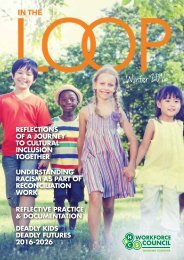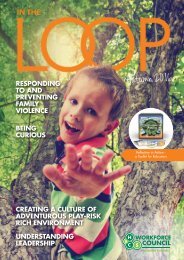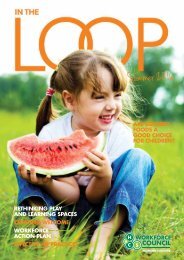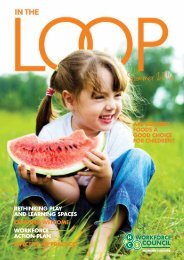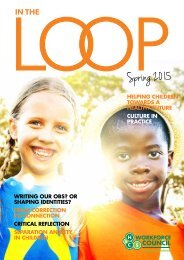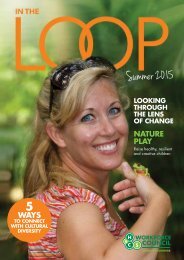Autumn 2015
Create successful ePaper yourself
Turn your PDF publications into a flip-book with our unique Google optimized e-Paper software.
STACIE’S STRATEGIES FOR ACCESSING CULTURE VIA FOOD<br />
BRING DIVERSITY TO YOUR<br />
VEGGIE PATCH<br />
1 4<br />
CONSULT WITH YOUR COMMUNITY TO<br />
DEVELOP A MULTICULTURAL MENU<br />
“Our garden has a number of vegetables and herbs from around<br />
the world that are starting to produce well. We have sugar cane,<br />
basil, Thai mint, Vietnamese mint and many more. Encourage<br />
families and staff to share cuttings of herbs or vegetables that<br />
they use in traditional foods. Garden to table works great in<br />
our centre! The children will pick the required herbs for our chef<br />
which brings authentic flavour to the day’s meals.”<br />
2<br />
CONSULT WITH FAMILIES ABOUT THEIR<br />
CHILDREN’S FAVOURITE MEALS<br />
“I always ask about children’s dietary requirements. Ask<br />
families to share recipes and incorporate them where<br />
possible,” advises Stacie. She says this provides a<br />
wonderful insight into their family life, culture, and gives you<br />
opportunities to be sincerely inclusive, and give all children<br />
in the service an opportunity to experience another culture.<br />
Stacie said it works even better if you can get the family<br />
to visit the service and teach/share the preparation with<br />
everyone. “One Mum, who is originally from China, came to<br />
our centre to help us with Chinese New Year celebrations. We<br />
enjoyed dumplings and made themed bookmarks. The Mum<br />
told us that they haven’t been able to celebrate their new year<br />
in the 3 years that they have been in Australia. She thanked us<br />
for making her feel welcome and for supporting their culture.”<br />
3<br />
ASK ABOUT FOOD PREFERENCES<br />
AT ENROLMENT<br />
Stacie recommends sharing your existing menu and finding<br />
ways to incorporate the family’s culture. Some of the questions<br />
that you might like to incorporate are;<br />
What foods do your family like to eat?<br />
What are your child’s favourite foods?<br />
What foods do you encourage for your child’s health?<br />
Are there any foods you like to avoid?<br />
What time of day does your child typically eat meals?<br />
How/where do you feed your child? Does your child feed<br />
him/herself?<br />
What eating utensils does your child typically use?<br />
Who usually eats meals with your child?<br />
Which foods do you eat on holidays or special<br />
occasions?<br />
Do you have any recipes that you would like to share for<br />
our menu?<br />
We have a community vegetable garden. Would you like<br />
to suggest any herbs or vegetables that we could grow<br />
together?<br />
Stacie shares an inspiring example: “About 6 months ago we<br />
realised that we had a lot of vegetarian families. This led us<br />
to explore the food practices of families much more deeply.<br />
We emailed all families to advise that we were changing our<br />
menu and asked if they could share with us any traditional<br />
meals that their children loved at home. From this survey, we<br />
picked and tested about 50 different recipes. For 6 weeks the<br />
children ate a different meal each day! The menu we have<br />
today is very multicultural and offers a vegetarian option<br />
every day. We also love that it is based on the recipes that the<br />
children picked, therefore the ones they liked best!”<br />
5<br />
USE THE CULTURAL KNOWLEDGE IN<br />
YOUR TEAM<br />
Stacie believes that this is essential. “What makes this work<br />
possible is that I have a team of educators and a chef who<br />
really support it. They are very on board and share their own<br />
culture. I find learning about different cultures fascinating and<br />
a lot of our discussion about culture comes from talking about<br />
food. It’s an easy way to break down those barriers. My team<br />
will bring and share different cultural foods like dumplings or<br />
jellyfish salad. Some of them we instantly love and some of<br />
them take a bit longer. I always ask them for recipes for my<br />
own home cooking. I hope it shows my interest and support for<br />
them to include their culture and family life in our centre”. The<br />
end result of this is educators who feel empowered to offer their<br />
cultural knowledge to better support children in the service.<br />
5<br />
SHOW YOU SINCERELY CARE<br />
“My team are genuinely interested in learning about and<br />
supporting families’ culture. Our families are closer and want<br />
to share their stories because we have shown them that we will<br />
act on the information they share. It also has given us some<br />
great insights into children’s behaviour. One of the interesting<br />
things that we learned is that many of the children are used to<br />
and prefer eating spicy food. We actually had to find ways that<br />
children could make their food spicier to encourage them to eat!”<br />
Would you like support in designing a more culturally<br />
inclusive approach to food in your service? The Bicultural<br />
Support Service at MDA work with ECEC services to help<br />
meet the specific needs of children and families from<br />
culturally and linguistically diverse (CALD) backgrounds.<br />
We provide mentoring, role modelling, cultural<br />
conversations and practical support, enabling educators<br />
to gain skills, knowledge and confidence to successfully<br />
include children and families from CALD backgrounds.<br />
The information and advice service can be contacted on<br />
ph 3337 5427 or email bsa@mdaltd.org.au<br />
For more resources on food and cultural inclusion visit us<br />
on Pinterest www.pinterest.com/BSSMDA/ or Facebook<br />
www.facebook.com/BiculturalSupportServiceMDA<br />
1. EYLF pg 13.<br />
2. Dr Donna Gabaccia, We are what we eat: Ethnic food and the making of Americans. Harvard University Press; 1998.<br />
3. Christine Gross-Loh, Parenting Without Borders. Penguin Books, 2013.<br />
4. Source – MDA, CSW Fact Sheets. Various CSWs.<br />
5. UNICEF global databases, 2014, based on MICS, DHS, and other nationally representative surveys, 2009.<br />
12<br />
IN THE LOOP



